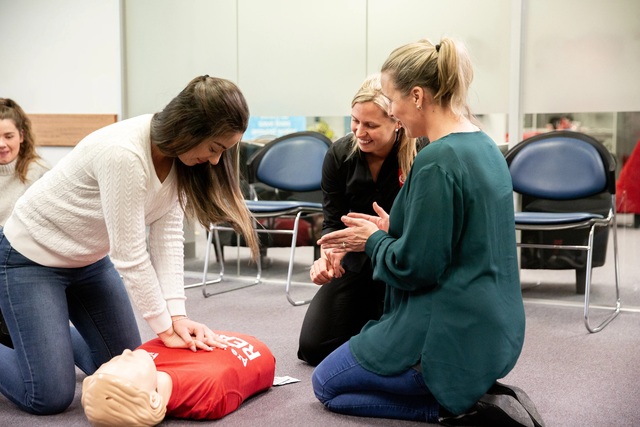
By Mikayla van Loon
Learning first aid and CPR can be the difference between a life bettering or saving result and not, yet new St John Ambulance research shows that very few people are trained and confident.
Mooroolbark resident and St John first aid training team leader Maree O’Malley said while heart attacks and strokes are usually what people turn their mind to when thinking about first aid, often the more minor incidents are where people apply their skills.
“That’s what people think of when they think of first aid because they’re life threatening,” she said.
“But then we’ve got the things like drowning, it doesn’t take much for a child, particularly, to drown, driveway accidents is another big one but it’s also things like your cuts, your grazes, your wounds, your bleeding, your burns.”
A survey undertaken by St John Ambulance has shown seven in 10 (76 per cent) Australians have witnessed a health or medical emergency but only one in 10 (nine per cent) say they would be very confident in their ability to provide first aid in an emergency.
More so, almost two in three (62 per cent) people say no one in their home has received first aid training.
In an effort to improve first aid knowledge in the home, especially as preventable visits to medical services seem to be rising, St John has launched the campaign ‘If it happens in the home, know first aid’.
Ms O’Malley said of course, in instances of heart attack or stroke, the more quickly care and treatment can be administered the better, but that also goes for preventing ongoing treatment for other more minor ailments.
“80 per cent of sudden cardiac arrests happen in the home. That’s when we don’t have the medical professionals on standby, we don’t often have defibs or easy access to them, so it’s about getting them that critical care for the chain of survival,” she said.
“In the case of CPR, early access to the defib in that first three or four minutes and then getting access to advanced care, first aid can decrease the ongoing treatment they need.
“If we burn ourselves and just run it under the tap for a bit and leave it, we can end up with a much worse situation than if we did our 20 minutes, which is what’s recommended.
“When you learn first aid, knowing what you can do to decrease the situation, the person is less likely to need ongoing care or more serious treatment.”
Ms O’Malley said for people who don’t know first aid and CPR, while intentions might be genuine, sometimes wrongly administered help or actions can have “detrimental effects”.
This is particularly true in cases of dislocation where trying to pop something back in may lead to a longer recovery time.
Being prepared is also an essential step in the process and Ms O’Malley said having a first aid kit in the home and in the car may mean a sprained ankle doesn’t require a doctor’s visit but instead can be bandaged correctly by a family member.
First aid accreditation, Ms O’Malley said, is not only about the practical application but also the ability to calm one’s self in a stressful situation, to manage the scene and apply the steps without injuring yourself in the process.
“If someone has done basic first aid, they know how to manage a scene and that’s really what it comes down to.
“I’ve had people tell me about situations where they’ve come across car accidents, and it’s just really about managing the scene where other people might panic, but you know what to do.
“You have a basic understanding of it. You know exactly what you’re working with. You know your first step is going to be to assess the danger. You want to make sure that the person who’s doing the first aid is also safe, we don’t want to end up with more casualties.”
And in cases of forgetting the right steps or what to do first, Ms O’Malley said St John Ambulance has an app which is a great refresher resource.
Emergency Plus is another recommended application because it pinpoints a GPS location in the case of an emergency when off the beaten path or on a rural road.
While at the moment the research shows millennials would be the most likely to administer first aid and Gen X the least comfortable, Ms O’Malley said with so many school based programs that St John runs, hopefully young people will build a natural confidence in this skillset.
Building a strong and confident base of first-aiders, Ms O’Malley said will make a large difference to care and treatment response, deliver better outcomes and prevent unnecessary visits to hospitals and GPs.
“First aid, it’s not scary. It seems like a big topic, but when you come to a class, it’s broken down for you. You can ask questions, there are no silly questions.
“It’s just really about encouraging people just to have a go out there, to look around the house and ask what’s safe, what’s not? Do we have a first aid kit in our house?”
With pre-learning classes, virtual first aid courses and traditional in-person courses, there’s an option for every schedule. First aid is meant to be refreshed every three years, while CPR is every year.
To learn more about St John Ambulance First Aid training, visit: knowfirstaid.stjohnvic.com.au






